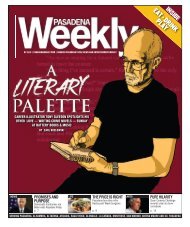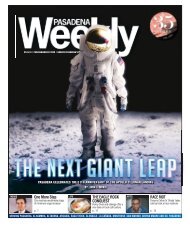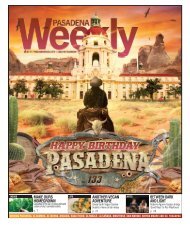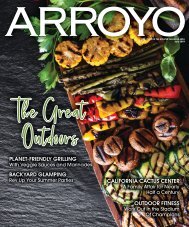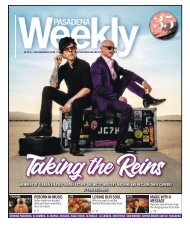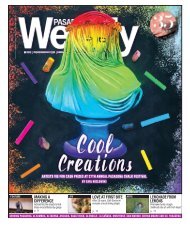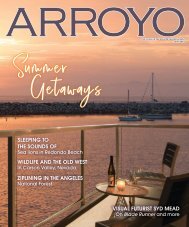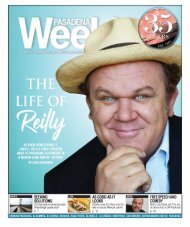05.09.19
Create successful ePaper yourself
Turn your PDF publications into a flip-book with our unique Google optimized e-Paper software.
SPOTLIGHT ON<br />
ARTISTS AND SCIENTISTS PRESENT MACH<br />
33: THE CALTECH-PASADENA PLAYHOUSE<br />
FESTIVAL OF NEW SCIENCE-DRIVEN PLAYS<br />
BY BLISS BOWEN<br />
SCIENCE<br />
Who gets to be a scientist? What does our attitude toward science<br />
say about us as a society? What do we do if we possess scientific<br />
knowledge but society won’t listen?<br />
Those are some themes addressed in the three plays receiving staged readings<br />
this weekend during Mach 33: the Caltech-Pasadena Playhouse Festival of<br />
New Science-Driven Plays, part of the Playhouse’s ongoing community outreach<br />
efforts. Intended to “energize the conversations about scientific, mathematical,<br />
and technological questions,” the readings will be followed by panel<br />
discussions with scientists from Caltech and JPL.<br />
Interestingly, all three plays are period pieces. James Armstrong’s “Bones of<br />
the Sea,” helmed by London-born director/actor Satya Bhabha, concerns 19thcentury<br />
British paleontologist Mary Anning and her landmark discoveries despite<br />
establishment bias against her because she was not formally schooled,<br />
wealthy, an Anglican, or a man. Susan Bernfield’s “Sizzle, Sizzle, Fly,”<br />
directed by Rhonda Kohl (who choreographed and assistant directed<br />
the Playhouse’s recent production of “Native Gardens”), time travels to<br />
the 1960s, when miniskirted “computress” Frances “Poppy” Northcutt<br />
became the first woman to join NASA’s Mission Control team.<br />
Award-winning playwright Kristin Idaszak’s “The Surest Poison,”<br />
directed by LA-based Randee Trabitz, applies hardboiled noir<br />
style to a Prohibition-era mystery that imagines real-life toxicologist<br />
Alexander Gettler and flapper reporter Lois “Lipstick”<br />
Long teaming to solve a murder.<br />
Taking its title from Ralph Waldo Emerson (“the surest poison<br />
is time”), “The Surest Poison” gathers dramatic momentum from Gettler’s mandate<br />
to “teach juries how to understand science.” The intersection of science<br />
and law was not well traveled in the pre-“Law & Order” 1920s, and civilians and<br />
law officers alike needed to be educated about scientific breakthroughs —<br />
and processes required for scientific findings to be reliable. (That remains<br />
true, as recent discoveries concerning blood spatter patterns have upended<br />
courtroom proceedings.)<br />
Like Armstrong and Bernfield, Idaszak, the daughter of chemical engineers,<br />
revised her script following input from Caltech’s Dr. Jay Labinger,<br />
who offered fruitful observations about how to stay faithful to scientific<br />
processes while making experiments onstage “legible” to audiences.<br />
“Because of the narratives that have entered our collective<br />
understanding around ‘CSI’ and how sophisticated our<br />
technology and science is, it doesn’t always tie up as neatly<br />
or translate as perfectly as we see on these [TV] shows. In<br />
some ways there is a continuing refining of how science and<br />
jurisprudence go together.<br />
“I am an expert in neither of these things; my training is<br />
firmly as a playwright,” notes Idaszak, who is also artistic director of Chicago’s<br />
CONTINUED ON PAGE 10<br />
<strong>05.09.19</strong> | PASADENA WEEKLY 9






